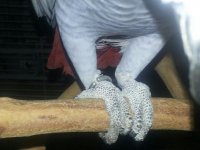Navigation
Install the app
How to install the app on iOS
Follow along with the video below to see how to install our site as a web app on your home screen.
Note: This feature may not be available in some browsers.
More options
You are using an out of date browser. It may not display this or other websites correctly.
You should upgrade or use an alternative browser.
You should upgrade or use an alternative browser.
Bands
- Thread starter Davinchi
- Start date
MonicaMc
Well-known member
- Sep 12, 2012
- 7,960
- Media
- 2
- 43
- Parrots
- Mitred Conure - Charlie 1994;
Cockatiel - Casey 2001;
Wild Caught ARN - Sylphie 2013
Just because he has an open leg band doesn't mean that he was wild caught, although it does make the chances that he is wild caught higher.
You'll have to take a close look at the numbers and letters to determine if wild caught or not.... and even if he was wild caught it doesn't mean that he was captured as an adult.... many chicks were taken out of the nest so never truly understood what it was like to be wild.
You'll have to take a close look at the numbers and letters to determine if wild caught or not.... and even if he was wild caught it doesn't mean that he was captured as an adult.... many chicks were taken out of the nest so never truly understood what it was like to be wild.
Echo
New member
- Dec 7, 2009
- 1,479
- 3
- Parrots
- Green Cheek Conures, Crimson Conures, CAG, Pionus, Budgies, Goffin Cockatoo
Monica is right, it doesn't make him wild caught as you can buy open leg bands in the US.
However, you can check the ring and see if there are letters that would indicate the name of one of the few quarantine stations around the country....
However, you can check the ring and see if there are letters that would indicate the name of one of the few quarantine stations around the country....
Last edited:
SoCalWendy
New member
That leg band would scare me, I would have it removed.
Featheredsamurai
New member
aw poor guy, you should have it cut off at the vet. Rosie my galah was double open banded for some reason(same identification on each band). They caused her a lot of problems. And please don't try to do it yourself, my vet had to use GIANT bolt cutters to get Rosie off. She came in with a big one that didn't work, left and came back with a monster bolt cutter lol. 2 people had to very carefully hold Rosie so there were NO mishaps.
Rosie's open bands told me she was imported through a private QT station in NYC
Here's some info on open bands from "winged Wisdom"
Rosie's open bands told me she was imported through a private QT station in NYC
Here's some info on open bands from "winged Wisdom"
Also just a heads up, I have already tried calling the USDA to see if they kept any records at all, they told me all the old records from before are gone. And the private parrot QT stations went out of business after it became illegal to import parrots for the pet trade along with any of their records.TRACING A BIRD'S LEG BAND
Whether imported or domestic, open or closed banded, the leg band carries letters and numbers which identify the bird. Import bands are traceable. Domestic bands purchased from bird associations and some commercial vendors are also traceable.
Imported Birds
Imported birds are open banded at the quarantine stations before release. There are two types of quarantine stations, privately owned commercial import stations and USDA-owned and operated stations. The coding on the leg bands is different for each. The following information on import bands was printed in an article from Pet Business Magazine June, 1987 and may have changed since then.
USDA-owned and operated quarantine stations use bands with letters and three or four numbers. The letters refer to the name of the station:
The letters on the leg bands of USDA-regulated pet bird quarantine stations refer to location and are followed by three or four numbers:
- Honolulu, HI - HH
Key West, FL - T
Miami, FL - 58A, 58B, 58C, 58D, 58E, 58F or USDA-F
Newburgh, NY - NNY
Privately owned commercial import stations use bands with an alphanumeric code - three letters followed by three numbers. The first letter signifies the state in which the station is located:
- Brownsville, TX - USDAB
Honolulu, HI - USDAH
Los Angeles, CA - USDAA
Miami, FL - USDAM
Mission, TX - USDAX ** for confiscated birds being put up for auction.
Newburgh, NY - USDANNY
San Ysidro, CA - USDAN
California - C,O
Florida - F
Hawaii - H
Illinois - I
Louisiana - L
Michigan - M
New York - N
Texas - T
The second letter denotes the quarantine station, while the third letter is part of the bird's ID number. For additional information regarding the numbers and letters on a bird's import band, call the USDA Administration Office Department of Agriculture, Fish, & Wildlife.
Last edited:
Most Reactions
-
 621
621 -
 265
265 -
 227
227 -
 176
176 -
 150
150 -
 108
108 -
 105
105 -
 82
82 -
 70
70 -
 55
55 -
O
52
-
 45
45 -
 43
43 -
 40
40 -
 35
35
Similar threads
- Replies
- 2
- Views
- 491
- Replies
- 7
- Views
- 822
- Replies
- 3
- Views
- 1K
